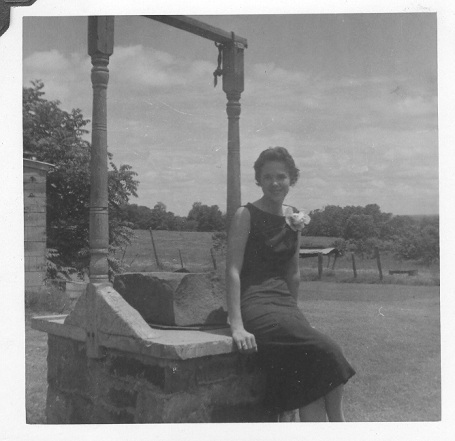IF IT’S MONDAY, IT’S WASH DAY–IF IT’S SATURDAY, IT’S BATH NIGHT
I am a city girl. My parents grew up on farms or in the country. One grandfather was an onion farmer in Laredo, Texas. The closest I came to being a country girl was when we lived in Charleston, Arkansas, in the late ‘40s and early 50’s when my dad was stationed at Fort Chaffee. Our home was a mile from highway 22 that connects Fort Smith and Dardanelle. The house came with a few acres of pasture land, a shed, a barn, chicken house, and a two- holer outhouse. Before Dad went to Japan, we had a cow, a calf, a large garden, and chickens. We had electricity but did not have indoor plumbing—we drew water from a well.
No indoor plumbing created some hardships, especially on wash days and bath nights. For each situation, many buckets of water were drawn from the well and poured into a No. 2 metal tub that sat on top of the stove where it was heated. When the water was hot enough for laundry, the tub was either lifted off the stove or emptied by a small pan to the washing machine.
Wash day was pretty much an all day job, and Monday was wash day. This was probably because we did not have a lot of clothes and the chore was better done at the first of the week instead of waiting until later in the week. Even today Monday is still my wash day, although when I worked outside the home, the weekend was laundry time. Back to the “olden days”—at least we didn’t have to use lye soap and heat water in a black kettle in the yard–the laundry was first sorted into three groups—whites, light colors, and dark colors. The same water was used for each load, so the hottest water was for the least dirty items. The wash water remained in the washing machine, so at least two wash tubs of rinse water were needed. The wringer swiveled which allowed it to be moved from washing machine to rinse tubs. The tubs sat on stools. After clothes were washed and rinsed, laundry that needed starch was set aside, and the other items were ready to hang on the line.
Spray starch was not available then—the starch solution had to be prepared each laundry day. A dry powder very similar to corn starch (as far as I know it could have been corn starch) was mixed with cool water to make a thin paste and this solution was slowly added to hot water stirring all the while to prevent lumps—just like you make a lemon pie or gravy. The thick solution was diluted with more water. Clothes that needed starch were put into the solution, then run through the wringer and hung out to dry.
Wet laundry was hung on an outside clothesline with clothes pins. The ones with springs worked best. If it was rainy or damp, laundry was hung around the house on make-do lines. If there were enough lines, all the laundry could hang at one time. If not as soon as clothes were dry, they were brought in and more hung out. Laundry hung outside has such a fresh sweet odor that is not available commercially.
We probably did the laundry on Saturday when mother went to work at Fort Chaffee—I don’t remember. I helped with the laundry in the summers and my brothers probably did too. It was a big job. Tuesday was ironing day. The starched items were sprinkled and rolled up, put in a basket, and covered so the dampness would spread evenly. There were no spray irons then. If the ironing was not finished, it could always be put in the refrigerator until there was time to finish.
We didn’t have as many clothes then as people do now. I shared a closet that was about 4 feet wide with my little sister. We also wore our clothes several times before they were washed. I don’t remember our clothes or us smelling bad.
If it’s Saturday, it bath night. Baths required the same heating process for the water. We used the No. 2 tubs also for bathing. My mother’s folks had a regular tin bath tub where you could stretch your feet out, but in the No. 2, you had to sit cross-legged. We kids used the same bathwater, which sounds gross now. My sister and I probably took baths first, since we were cleaner than our two brothers. My parents may have used fresh water, I don’t remember. Hair was washed over the sink. The rest of the week we sponged off.
We returned to Charleston from Japan in August of 1955. I graduated from high school in Japan and was getting ready for college. The folks got indoor plumbing then and had an automatic washer and dryer, which certainly made laundry much easier. We were married seven years before I got a washer and dryer—had to use a Laundromat. When we moved to East Texas, I tried to hang clothes outside on dry days, but it was too humid. I am thankful for modern conveniences that make wash days and bath times better.
